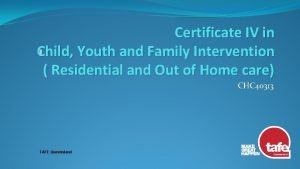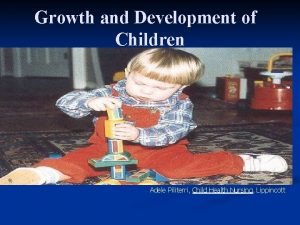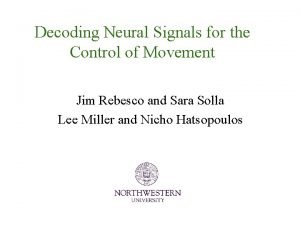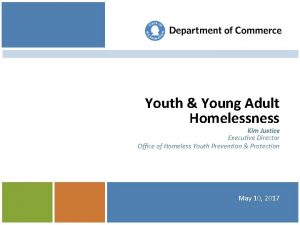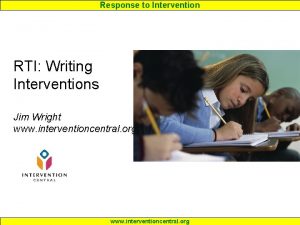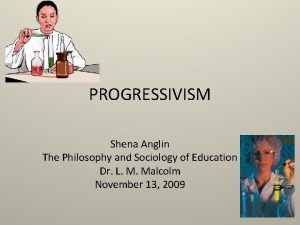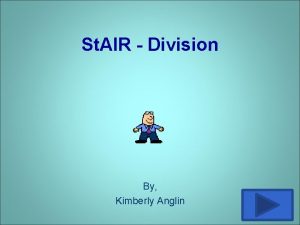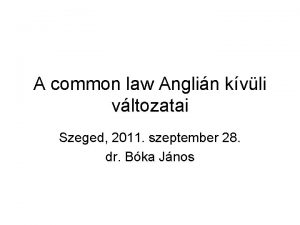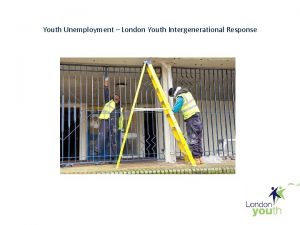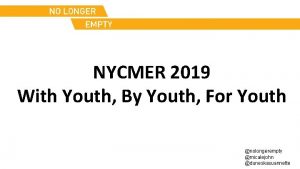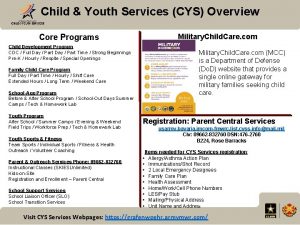Professor Jim Anglin School of Child and Youth















































- Slides: 47

Professor Jim Anglin, School of Child and Youth Care SIRCC Conference, June 8, 2011

It’s nice to be back in Oz…

Victoria, BC, Canada

New Directions in Policy and Planning for Residential Care

Resi Rocks 2013!

Key Issues and Themes in Therapeutic Residential Care (adapted from Whittaker, del Valle & Holmes, forthcoming) Overarching Issues • What is therapeutic residential care? • What is the place of therapeutic residential care in the system of child welfare and out-of-home services? • What are the “active ingredients” of therapeutic residential care? • What characteristics of young people indicate the need for therapeutic residential and out-of-home care? • What other factors indicate which type of placement would be suitable for individual children? • Why is there a current climate of negativity in some jurisdictions (e. g. USA)? • What do we know about cost-effectiveness and value for money in residential care? • What outcomes can be expected from residential care?

Thematic Areas for Consideration • Promising program models and innovative practices in therapeutic residential care • The challenge of the demand for evidence-based practice • Transition/pathways of young people out of therapeutic residential care • The state of current research and program evaluation – what do we know now? • Staff training and organizational development for therapeutic residential care • How do we shape the future of therapeutic residential care practice and research?

What is therapeutic residential care? Therapeutic Residential Care is intensive and time limited care for a child or young person in statutory care that responds to the complex impacts of abuse, neglect and separation from family. This is achieved through the creation of positive, safe, healing relationships and experiences informed by a sound understanding of trauma, damaged attachment, and developmental needs. [Source: National Therapeutic Residential Care Working Group, Australia] Therapeutic residential care involves the planful use of a purposefully constructed multi dimensional living environment designed to enhance or provide treatment, education, socialization, support and protection to children and youth with identified mental health or behavioral needs in partnership with their families and in collaboration with a full spectrum of community based formal and informal helping resources. [Source: “Nominal” definition, Whittaker, del Valle and Holmes text, forthcoming]

Definitional emphases Victoria TRC intensive time-limited statutory care Whittaker et al. planful purposeful complex trauma mental health and behavioral needs healing relationships multi-dimensional attachment and development family & community partnerships

What is the place of therapeutic residential care in the system of child welfare/out-of-home services? • Therapeutic residential care is a new concept, therefore it is too early to answer this with any confidence. • However, it would seem logical to locate therapeutic residential care somewhere between “regular” group care & treatment foster care and residential treatment centres. • It is suggested that it be used judiciously and for “high-need children and youth with multiple challenges” (Whittaker). • It should also be engaged in active partnership with families (parents and extended family members) and in close collaboration with community-based services, such as schools, recreation, youth groups etc. ) • Its use could reduce or eliminate the need for secure care in child welfare (as opposed to corrections and psychiatrics)

The system of out-of-home services • • Listed according to intensity and cost adoption kinship care “conventional” foster care treatment (specialised or therapeutic) foster care parent model group care homes “conventional” staffed group care therapeutic residential/group care residential treatment (mental health) and correctional facilities (centres, wilderness, homes)

The use and availability of each of these options is related to a number of important factors, including: • • political ideology and commitment community cultural practices service system histories and traditions economic situation research and evaluation findings advocacy costs others?

The challenge of decision rules For example: • All children have a right to live in a family (except those who can’t) • Try (all) less intrusive services before more intrusive alternatives (but less intrusive for whom? ) • Place a child in residential care only as a last resort (which may mean years of misplacements and pain) • Every child has a right to permanency and stability (but what do we do to ready them for such a place? ) • Others?


What are the “active ingredients” of therapeutic residential care? The exemplars with which I am familiar include the Sanctuary© model, the Cornell CARE © model and the Victoria TRC model. Candidates for key active elements would appear to include: The struggle for congruence in service of the best interests of children as the central concern or programmatic touchstone Also, a set of guiding principles (see Holden, 2009) - - developmentally appropriate; family involved; trauma informed; relationship based; competence centred; ecologically oriented culturally responsive

And eleven interactional dynamics (from Anglin, 2002) • • • listening and responding with respect; communicating a framework for understanding; building rapport and relationship; establishing structure, routine and expectations; inspiring commitment; offering emotional and developmental support; challenging thinking and action; sharing power and decision-making; respecting personal space and time; discovering and uncovering potential; and providing resources

There is also the need to create a therapeutic residential care, or “child’s best interests” culture

some structural aspects… • • • organizational and system congruence transformational leadership and management effective supervision skilled and professional child and youth workers appropriate range of specialists, appropriate roles opportunities for frequent dialogue and sharing ongoing training and professional development ongoing evaluation of outcomes adherence to quality standards appropriate rostering (staff shift patterns) etc.

What characteristics of young people indicate the need for residential and out-of-home care? There is the longstanding issue of labeling; here are some popular in the pre-1970 s (although we can still find them) • • • Disturbed Delinquent Dysfunctional Deviant Defiant Diseased Deprived Disobedient & Troubled (“D” words from Reclaiming Youth at Risk, (1990) Brendtro, Brokenleg and Van Bockern)

Some of the more recent (post 1970) terms… • • • at risk children (and youth) vulnerable children maltreated children neglected or abused (or who are at risk for potential abuse) children in need of special protection (UNCRC) children in need of protection children with complex needs high-need children with challenging behaviours children with high service needs traumatized children add your own… * And there is the important issue of children’s “well-being”

What characteristics of young people indicate the need for residential and out-of-home care? • will not accept or benefit from a familial environment • have a range of complex needs requiring multidimensional care • require intensive, consistent and skilled response 24/7 • need long-term care where family care is inappropriate; • need additional specialist services on intensive basis.

What other factors indicate which type of placement would be suitable for individual children? • • Foster care or residential care? Group homes are not families; a strength for some young people (level of intimacy) Child expected to fit in with family versus group home designed to adjust to needs of the child Sense of ownership of home and contents Number of carers and children present, potential relationships Shifts of staff versus 24/7 parent(s) Intensity and consistency of therapeutic care Presence of on-site supervision Preference of young person, often demonstrated by behaviour

Why is there a current climate of negativity in some jurisdictions (e. g. USA)? • Residual effects of Goffman’s exposé of the negative impacts of “total institutions” (Asylums, 1961) • Historical and repeated instances of abuse • Ideologies (e. g. “every child should live in a family”; “try everything before resorting to residential care”) • Misapplication of attachment theory • Deinsitutionalisation movement • Focus on permanency planning • Least intrusive intervention principle • Costs of delivery

Residential/group home care has proven to be resilient • No jurisdiction I am aware of has been able to eliminate all residential care; some have sent young people out of their jurisdiction to avoid provision, or have seen serial foster care placements (e. g. Warwickshire County in UK) • In most jurisdictions, the use has lessened and focussed on small group residences (e. g. 2 -8) (ranges from 1% of children in care in Queensland 3% in NSW (2005), to 92% in Japan. Canada approx. 15%, USA 19% and Scotland 23%. But Japan has 17 CIC per 10, 000 versus 58 for Queensland NSW)

What outcomes can be expected from residential care? • Experiential outcomes – changes in how young people experience themselves and make meaning of their worlds • Developmental outcomes –changes in aspects of a child’s development, including cognitive, behavioural, social, educational, moral etc. • Program outcomes – changes in system indicators, such as lengths of stay, number of placements, number of incidents, number of restraints, absconding rates, etc.

From TRC Evaluation (November, 2011) Significant improvements in placement stability Children and young people placed in a TRC have experienced far greater stability compared to their previous experience. Significant Improvements to the quality of relationships and contact with family The children and young people in TRC have experienced and sustained significant improvements to the quality of contact with their family during their period in TRC. Sustained and significant improvements to the quality of contact with their residential carers over time in the TRC pilots Children and young people in the TRC pilots are developing and sustaining secure nurturing, attachment-promoting relationships with residential carers in the TRC Pilots.

Increased community connection Children and young people in the TRC Pilots were more likely to engage in community activities or have a part time job than young people in general residential care. Significant improvements in sense of Self Children and young people in the TRC have experienced and sustained significant improvements in their sense of self, indicating improved mental health. Increased healthy lifestyles and reduced risk taking Children and young people in the TRC experienced a reduction in risk taking which was evident over time in reduced episodes of negative police involvement (although not immediate), police charges and secure welfare admissions. Enhanced mental and emotional health Across the SDQ and Ho. NOSCA measures, the children and young people in the TRC experienced improvements and significant reductions in the mental health symptom severity.

Some preliminary feedback on CARE© program Workers in CARE agencies often report that things are more calm and peaceful in the cottages, there is less fear, and there are fewer confrontations and power struggles. Many workers report they are happier and feel more satisfaction in their work. As a result of experiencing CARE concepts, materials and workshop sessions, agency leaders become aware of the need to review and revise their agency policies, procedures, practices, and structures, in order to be congruent with CARE.

Promising program models and innovative practices in therapeutic residential care There is the pesky “black box” issue; we often don’t know exactly what is being evaluated To my mind, candidates for further evaluation as therapeutic models would include: • • • Victoria TRC model Cornell CARE© model Sanctuary© model ? ?

The challenge of the demand for evidencebased practice • Key criterion is evidence from randomized controlled trials • It takes about 12 -15 years to develop models, implement programs and amass evidence • Requirement for “manualisation” • Unclear if quasi-experimental designs will make the EBP grade • We may be limited to “promising practices” according to the rating scheme of such organizations as the CEBC (California Evidence-Based Clearing House for Child Welfare) • Will this limit the use of tried and true “practice-based evidence”?

Definition of Evidence Based Practice The Institute of Medicine (IOM) defines "evidence-based practice" as a combination of the following three factors: (1) best research evidence, (2) best clinical experience, and (3) consistent with patient values (IOM, 2001). These three factors are also relevant for child welfare (From CEBC web-site)

1. Well Supported by Research Evidence • There is no case data suggesting a risk of harm that: a) was probably caused by the treatment; and b) the harm was severe or frequent. • There is no legal or empirical basis suggesting that compared to its likely benefits, the practice constitutes a risk of harm to those receiving it. • The practice has a book, manual, and/or other available writings that specify components of the service and describes how to administer it. • Multiple Site Replication: At least two rigorous randomized controlled trials (RCTs) in different usual care or practice settings have found the practice to be superior to an appropriate comparison practice. The RCTs have been reported in published, peer-reviewed literature. • In at least one RCT, the practice has shown to have a sustained effect at least one year beyond the end of treatment. • Outcome measures must be reliable and valid, and administered consistently and accurately across all subjects. • If multiple outcome studies have been published, the overall weight of the evidence supports the benefit of the practice.

Transition/pathways of young people out of therapeutic residential care • planning for exit needs to permeate the program on ongoing basis, not be an add-on or last minute intervention when it is common for youth to “regress”. • If a child is returning home, often intensive intervention efforts are directed at improving family function, while little or nothing is done to support youth transitioning to independent living. • a newly conceptualized stage of development, the “emerging adult”, spanning the ages of about 18 -26 is being researched and indications are that the needs of young people exiting care quite similar to normative youth trajectories (Mann. Feder, 2011) • Adaptation to living on one’s own takes time and support, for the majority of all young people (emerging adults).

The state of current research and program evaluation – what do we know now? - about residential care, in general

“A Review of Residential Mental Health Placements for Children and Youth” (Frensch and Cameron, 2002) “Unfortunately, any gains made by reconceptualizing the practice of residential treatment will be overshadowed at present by the limitations of current methods for studying residential treatment. Research in this area continues to be plagued by serious methodological flaws. ”

“A Review and Meta-analysis on the Outcomes of Residential Child and Youth Care” (Knorth, Harder, Zandberg and Kendrick, 2007) “The main conclusion that can be made from our meta analysis is that children and youth, after a period of residential care – on average – improve in their psychosocial functioning. […] The effect sizes that we found are in most cases positive and can be characterized as ‘medium’, sometimes as ‘large’. […] [R]esidential care seems to achieve better results than treatment at home with the same (very) problematic group. ” (p. 136)

From “What Works in Group Care? ” (Sigrid James, 2010) • Research on 5 models was reviewed • “Four of the models were rated as either being supported by research evidence (PPC) or being promising (TFM, Sanctuary Model, Stop Gap). The Re Ed model could not be rated due to a lack if evaluative data which would meet CEBC* rating criteria. ” *California Evidence Based Clearinghouse (i. e. randomized controlled trials)

Sigrid James (2010, cont’d) “ Research on group care remains in early developmental stages, and as this review indicated, far too few rigorous studies have been conducted to make a strong recommendation for one or other treatment model. ”

The state of current research and program evaluation – what do we know now? -about therapeutic residential care • Given the recentness of the concept of “therapeutic residential care”, and the relatively few program models with at least many of the “active ingredients or elements”, it is fair to say that evaluation is in its infancy. • However, initial and preliminary results appear promising.

Calculating the costs for therapeutic residential care • Residential care is an expensive service when compared with various forms of foster care, kinship care or adoption. • Therapeutic residential care is more expensive than “regular” group care, however, it is less costly than secure care, juvenile detention centres or psychiatric wards in hospitals. , and it can reduce significantly services required by care leavers(Department of Youth Safety, 2011). • One can think of therapeutic residential care as like the “intensive care service” of child welfare; no one seriously considers eliminating intensive care in hospitals because it is too expensive. It is an important part of the medical system.

Staff training and organizational development for therapeutic residential care • In order to create or re-create an organisational culture according to therapeutic care principles and values, all agency staff members need to complete intensive collective training • My research on the implementation of the Cornell CARE© model indicates the need for an intentional process of adult mindset development (i. e. moving from a socialized to self authoring to self transforming mindset; Kegan and Lahey, 2009).

A congruent agency is needed to sustain the developmental processes Openness to change/ lack of rigidity Develop a common language Leaders model learning mode Accountable to same goal or purpose People valued as individuals Working on the same page/lack of role conflict Safe to make mistakes Work environment experienced as supportive Integrates learning mode into operating mode A Congruent Organisational Culture and Climate

Achieving a skilled and professional child and youth care worker workforce – 2 dimensions 1. Develop post secondary (college and/or university) programs to educate child and youth care workers. Most programs in North America and Europe have evolved beyond a single focus on residential care to equip workers to function effectively across a wide range of settings (e. g. school-based, hospital child life work, family support work, youth programs, early childhood care and education , child protection, etc. )

2. Bring quality training into residential agencies as part of a comprehensive approach to creating a “best interests” or therapeutic organizational culture. All staff members, from CEOs, to program directors, to supervisors, cooks, clerical staff, maintenance staff as well as child and youth care workers need to be introduced to the same values and principles, and their implications for responding to young people in a therapeutic way.

How do we shape the future of therapeutic residential care practice and research? What those who “believe in” the efficacy of well-designed and delivered therapeutic residential care will need to contend with: “This past August, the U. S. Annie E. Casey Foundation sponsored a symposium New York City on the effectiveness and place of residential care within a state or community’s child welfare system. The simple upshot was that national and international child welfare researchers and evaluators present [Ed. don’t know who] reached a consensus that residential care was not appropriate for children because of two primary reasons; the lack of precision parenting(services and programs do not focus on the individual child’s needs) and that children are less likely to form appropriate attachments in group care. ”

Such gatherings as this one here today provide excellent opportunities to share experiences and ideas, research findings, programmatic developments and professional aspirations with a cross-national perspective. Dr. Jim Whittaker is calling for a renewed and concerted focus on residential care with an emphasis on: • clear definitions of the service and its purposes, • effective and humane practices, • partnerships with families and community-based services, • research and evaluation evidence, • cross-national collaboration This seems like a timely and appropriate “call to action”.

Residential care is not rocket science; it is far more complex than that!
 Promotion from assistant to associate professor
Promotion from assistant to associate professor Child youth and family services act
Child youth and family services act Certificate iv child youth and family intervention
Certificate iv child youth and family intervention 전위 순회
전위 순회 Rights and responsibilities of a child at school
Rights and responsibilities of a child at school The gift of the magi characterization
The gift of the magi characterization Isagenix rank structure
Isagenix rank structure How do huck and jim dress on the raft
How do huck and jim dress on the raft Cattlelo
Cattlelo School-age child development stages
School-age child development stages Child-friendly school activities
Child-friendly school activities Child friendly school
Child friendly school Kepsha constitution
Kepsha constitution Cdc whole school whole community whole child
Cdc whole school whole community whole child The professor's beloved equation full movie
The professor's beloved equation full movie Jim meyer primerica
Jim meyer primerica Jim kenney harvard pilgrim
Jim kenney harvard pilgrim Jim gray database
Jim gray database The new jim crow chapter 1
The new jim crow chapter 1 The new jim crow chapter 2
The new jim crow chapter 2 Jim casy
Jim casy Dr jim young
Dr jim young Jim brau
Jim brau Sasquatch beef sticks
Sasquatch beef sticks Hp bought compaq
Hp bought compaq Jim shifflett
Jim shifflett Jim crow character
Jim crow character Nj.comhunterdon
Nj.comhunterdon Susquehanna valley sports
Susquehanna valley sports Jim boykin
Jim boykin Compsci 453
Compsci 453 Jim gallien
Jim gallien Ihealthevents.com
Ihealthevents.com Good to great chapter 8
Good to great chapter 8 Jim rebesco
Jim rebesco Jim isbell
Jim isbell Jim dunlop solar
Jim dunlop solar Jim getzinger
Jim getzinger Jim theofelis
Jim theofelis Jim keller discovery
Jim keller discovery Jim morrison crystal ship
Jim morrison crystal ship The gift of magi plot diagram
The gift of magi plot diagram Jim gray microsoft
Jim gray microsoft Writing interventions for rti
Writing interventions for rti A step away from them frank o'hara
A step away from them frank o'hara Dr. jim wright
Dr. jim wright Jim plourde
Jim plourde Slick jim won the lottery answer
Slick jim won the lottery answer


